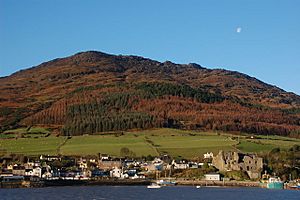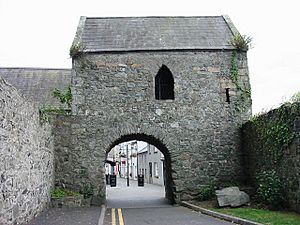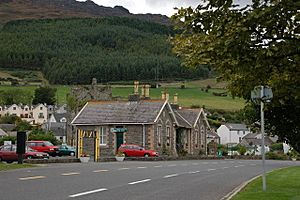Carlingford, County Louth facts for kids
Quick facts for kids
Carlingford
Cairlinn
|
|
|---|---|
|
Town
|
|

Carlingford below Slieve Foy
|
|
| Country | Ireland |
| Province | Leinster |
| County | County Louth |
| Elevation | 1 m (3 ft) |
| Population
(2016)
|
|
| • Urban | 1,445 |
| Time zone | UTC±0 (WET) |
| • Summer (DST) | UTC+1 (IST) |
| Eircode routing key |
A91
|
| Telephone area code | +353(0)42 |
| Irish Grid Reference | J185115 |
Carlingford is a lovely coastal town in northern County Louth, Ireland. Its name comes from an old Norse word meaning "narrow sea-inlet of the hag." The town sits on the southern shore of Carlingford Lough, with the impressive Slieve Foy mountain (also called Carlingford Mountain) behind it. It's the main town on the Cooley Peninsula.
Carlingford is about 27 kilometers (17 miles) northeast of Dundalk and 90 kilometers (56 miles) north of Dublin. It's also only about 11 kilometers (7 miles) south of the border with Northern Ireland. In 1988, Carlingford won the Irish Tidy Towns Competition, which means it was recognized for being a very neat and well-kept town.
You can still see Carlingford's old medieval design today, with its narrow lanes and small streets. On Tholsel Street, you'll find "The Tholsel," which was once a gate in the town's old walls and even used as a jail. Also on Tholsel Street is a 16th-century building called The Carlingford Mint.
Contents
History of Carlingford
How Carlingford Began
The Vikings came to Ireland in the 800s. Records show they used Carlingford Lough because it was a safe bay. Later, in the 1100s, a Norman knight named Hugh de Lacy started building a castle here. A town quickly grew up around this strong fortress.
The castle is now known as King John's Castle. This is because King John visited it in 1210. The castle is a large ruin built on a solid rock, with the sea on two sides. Mountains rise up on the land side, with a narrow path below that the castle used to guard.
Carlingford's Busy Years
Carlingford was an important trading port on Ireland's east coast, just like Carrickfergus and Drogheda. This trade made it quite rich in the 1300s, 1400s, and early 1500s.
However, in 1388, a Scottish army burned the town down. This was a punishment for Irish attacks on a place called Galloway in Scotland. Because of this and other raids, the town was allowed to stop paying a special tax called "tallage" in 1410.
Carlingford received five special documents called charters. These documents gave the town special rights and freedoms. The first one was from King Edward II in 1326, and the last was from King James I in 1619. More trade meant that wealthy merchants built grand buildings. You can still see parts of these buildings today, like The Mint and Taffe's Castle.
Carlingford was also famous for its green-finned oysters. Catching and selling these oysters, along with herring fishing, was a major way for people to earn a living. The oysters were well-known across Britain and Europe.
Times of Trouble
Several wars and conflicts in the 1600s caused problems for Carlingford. These included the Irish Rebellion of 1641, the Cromwellian Conquest in 1649, and the Williamite wars in the 1690s. These events hurt the local economy. By 1744, Carlingford was described as being "in a state of ruin." The biggest blow was when the large groups of herring fish left the lough in the early 1700s.
Carlingford Today
Because Carlingford didn't develop big factories, its old medieval layout and historical buildings stayed mostly untouched. In the 1870s, the Dundalk, Newry and Greenore railway opened, bringing tourists to Carlingford. This train line closed in 1951.
Today, tourism is a very important way for people to find work in Carlingford. Fishing is still important too, especially for oysters and crabs from the harbor. The town hosts the annual Carlingford Oyster Festival, usually in August. A passenger ferry also runs daily from the nearby village of Greenore during the summer.
In 1918, during a general election, a group called the Irish Volunteers came to Carlingford by train. They saw many people in Carlingford wearing Union Jack flags. The Volunteers asked the police officers to stay in their barracks while they were in town. There were some disagreements between the Volunteers and local crowds on the streets. The Volunteers helped protect voters going to cast their votes until the polling places closed. After voting ended, the Volunteers marched back to their home in Camlough.
Cool Places to Visit
- King John's Castle: Even though parts of this castle were built before 1186, it's named after King John, who visited in 1210. Other parts were added later, in the 1400s and 1500s. In the 1950s, work was done to keep the castle from falling apart. You can see great views of the harbor from the eastern side, but the castle itself is closed to visitors for safety.
- Taaffe's Castle / Merchant House: This is a strong townhouse that people say belonged to the wealthy Taaffe family. They became important lords in 1661. However, there's no real proof they built or owned it. It was likely a trading center on the ground floor, with living spaces above. The building shows it was built in two stages, with the main tower from the early 1500s and an extension added later.
- The Tholsel: This "town-gate" is the only one of its kind left in Carlingford and one of the few in all of Ireland. It used to be three stories tall, but it looks different now because of changes made in the 1800s. Its main job was to collect taxes on goods coming into the town. The small holes in the walls were for defense. In the 1830s, it was used for town meetings and even as a jail.
- The Mint: This is a strong, three-story townhouse that belonged to a rich merchant family. While Carlingford was given the right to make coins in 1467, it's unlikely this building was actually used as a mint. It has five beautifully decorated stone windows. The designs on them show the influence of a style called the Celtic Renaissance from the 1500s.
- Dominican Friary: The Dominican Order (a group of monks) came to Carlingford in 1305. The friary was dedicated to St. Malachy. In 1540, King Henry VIII closed it down. Later, the Dominicans left the friary in the 1700s and moved to Dundalk. Today, you can see the remains of the main church building and possibly some other old buildings nearby.
- Town Wall: A wall was started in 1326 to protect the town and collect taxes on goods entering it. Not much of the wall is left today. What remains shows openings for muskets, which were early firearms, meaning the wall was updated in the late 1400s. It probably had a ditch outside for extra defense. The wall also helped separate the local Irish people from the Normans.
- Ghan House: This is a beautiful Georgian house built in 1727. It's surrounded by old walls and a guard tower. The first floor has a drawing room with fancy plasterwork on the ceiling. The basement has two secret underground tunnels (now blocked). One tunnel supposedly led to a bakery and was used by a group of quiet monks who lived there and wanted to avoid talking to townspeople. Today, Ghan House is a guest house, a place for events, and a cooking school.
- Church of the Holy Trinity: This old church has been restored and is now called the Holy Trinity Heritage Centre. Inside, you can see exhibits that tell the story of Carlingford from Viking times to today. Music concerts are often held here. Outside, there's a graveyard.
- Market Square: This area, now the main street of Carlingford, was once where a weekly market was held. Records show its layout from as far back as 1358. It's now where Dundalk Street meets River Lane.
Getting Around Carlingford
Carlingford railway station opened on August 1, 1876. However, it closed on January 1, 1952, when the Dundalk, Newry & Greenore Railway stopped running. In 1948, a movie called 'Saints and Sinners' filmed a scene at the station.
Bus Éireann route 161 runs from Monday to Saturday. It offers seven trips to Dundalk (going through Greenore) and four trips to Newry (going through Omeath). This bus does not run on Sundays or public holidays.
On Sundays, Local Link Louth Meath Fingal route 701, run by Halpenny Travel, provides three trips to Dundalk and three trips to Newry (via Omeath).
Carlingford also has a marina, a place where boats can dock.
Famous People from Carlingford
- Terry Brennan (born 1942) is a politician who used to be a senator.
- Thomas D'Arcy McGee (1825–1868) was a Canadian politician. He was the first Canadian politician to be assassinated. He encouraged Irish Catholics to solve problems through peaceful parliamentary methods.
- Peter Boyle (1876–1939) was a footballer. He played five times for Ireland and was part of the Sheffield United team that won the FA Cup in 1899 and 1902.
- Arthur Moore received the Victoria Cross, a very brave award.
- Hans Moore (1834–1889) was a British Army Major who also received the Victoria Cross for his bravery during wars in South Africa.
- Rev. Lorcán Ó Muireadais (1883–1941) was a Catholic priest who worked to promote the Irish language.
- Daniel Joseph Anthony "Tony" Meehan (1943–2005) was a musician from London. He was a founding member of the famous band The Shadows. He played the drums on many early songs by Cliff Richard and The Shadows. He is buried in Carlingford cemetery.
Images for kids
See also
 In Spanish: Carlingford para niños
In Spanish: Carlingford para niños







